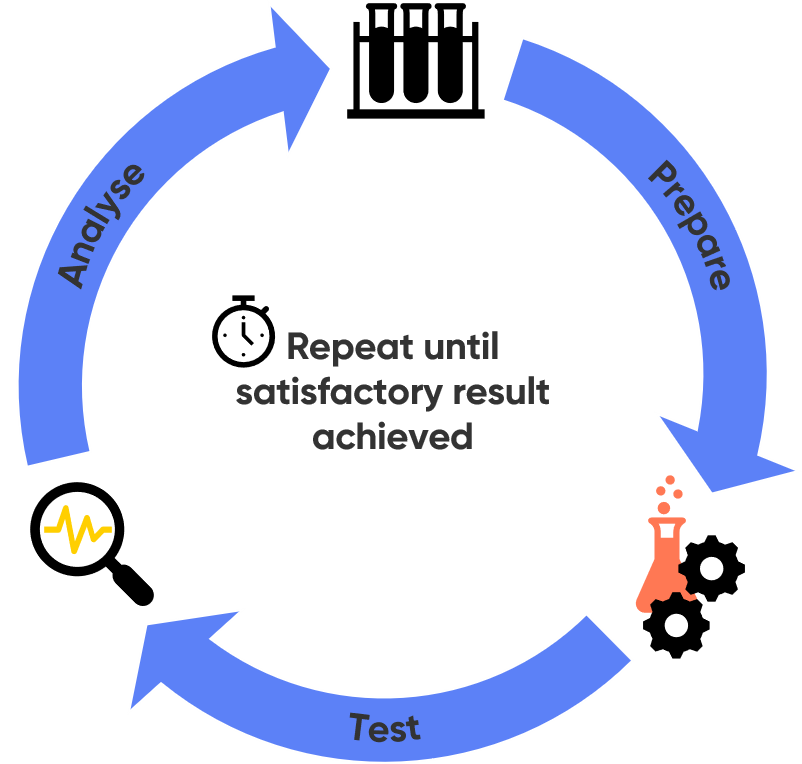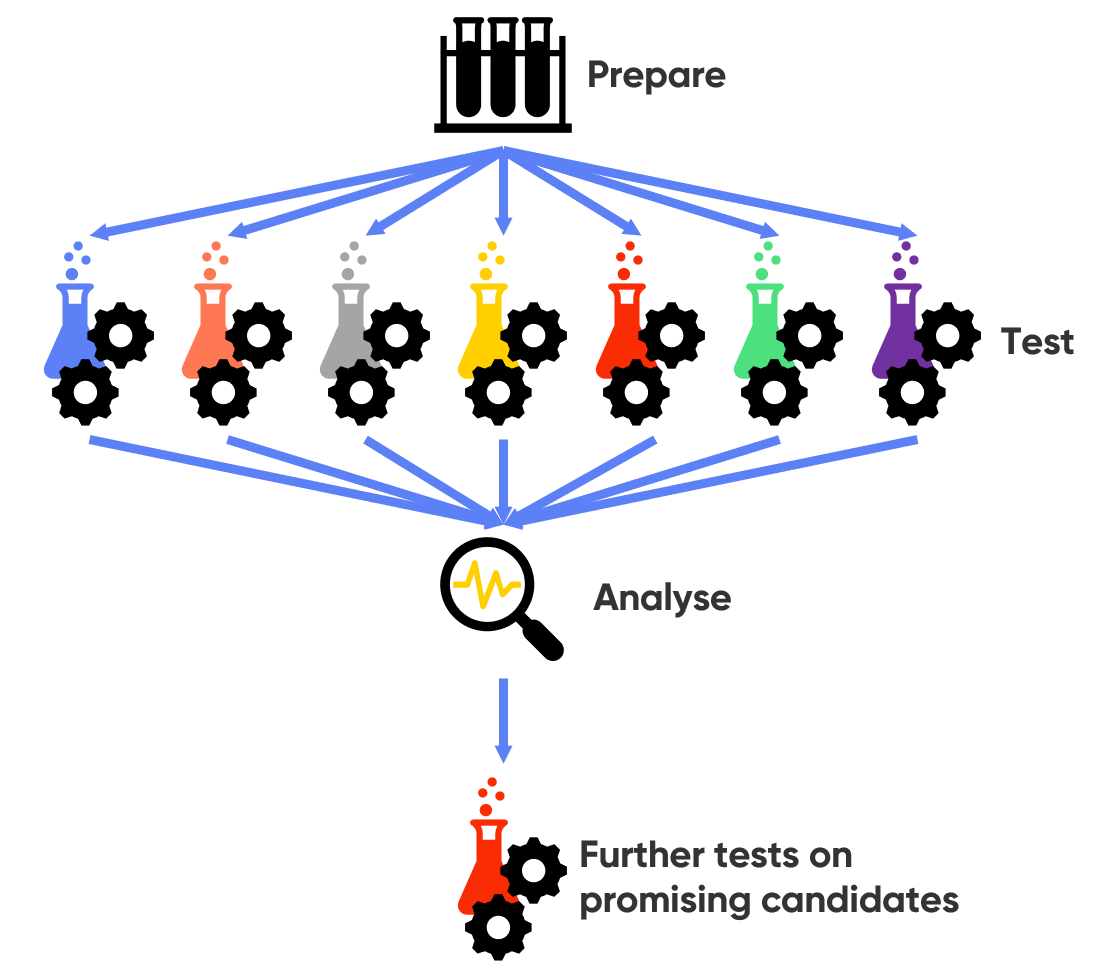Introduction to High Throughput Screening
Latest updated: November 18, 2024What is high throughput screening?
When investigating novel materials for electrochemical applications, screening studies are often used to determine the best candidates. In traditional electrochemical screening studies, experiments are performed in an iterative manner. This means the novel material is prepared, tested, and the results are analyzed before the process is repeated for a different composition, until a satisfactory result is achieved, as illustrated in Fig. 1. Note that what is deemed a satisfactory result will depend on the field the user is working in, for example in catalysis this may be a sample that gives a higher catalytic activity than available from existing catalysts. Iterative screening has the advantage that the composition for the next test sample can be informed by previous tests, however, it can be incredibly time consuming to carry out such iterative testing. In some cases, the time requirement can even make such an approach nearly impossible. This is particularly the case for novel alloys and electrocatalysts because of the infinite number of permutations of samples of interest possible. In these scenarios High Throughput Screening (HTS) is required. HTS allows many samples to be tested at once in a single experimental setup, as illustrated in Fig. 2, often through the production of combinatorial libraries of samples of interest. While it does not allow for new samples to be prepared based on information from previous tests, at least not in the first screening, the reduction in time for test more than makes up for this. As a result, HTS has been applied to various fields within electrochemistry including batteries [1], electrocatalysis [2], corrosion [3], sensors [4], and solar cells [5], and has even been combined with machine learning [3, 6-8].

Figure 1 : The traditional iterative testing approach used in electrochemical screening is illustrated.

Figure 2: The high throughput screening approach as used in electrochemical screening is illustrated.
Why is high throughput screening used?
Although the concept of high throughput screening is not new, its application to electrochemical screening has recently become popular. There are numerous other advantages which make HTS appealing in electrochemical applications. As we have already seen HTS can offer substantial time savings when performing electrochemical screening studies, especially when there are almost infinite permutations which need to be examined. This is also coupled with savings in materials required to study each permutation. HTS can also offer results which can be more reliably compared than those of iterative studies. In iterative electrochemical studies, the cell must be dismantled and re-setup for each sample of interest. This can lead to differences in the mechanical setup, not to mention environmental differences which can occur from day to day, which can make results difficult to compare [9]. Recent interest in high throughput screening has also been driven by the rise of artificial intelligence in research, particularly in the application of machine learning for materials prediction. To effectively use machine learning to predict new materials, databases of materials properties need to exist. HTS is seen as a way to quickly and affordably build up the large data sets required to produce the best predictions [3, 6-8].
Achieving electrochemical high throughput screening
When performing electrochemical high throughput screenings, potentiostats are the workhorses of the experiment, and can be used in a range of setups to perform HTS. Multichannel potentiostats can be used to perform multiple electrochemical experiments at one time, taking advantage of their ability to setup multiple cells and tests for simultaneous experiments. They can also be coupled with a multielectrode array for simultaneous experimentation. Potentiostats can also be combined with more complex setups, such as those performing automated serial experiments [1]. When working with BioLogic’s instruments, this can be implemented using the EC-Lab® Developer Package.
Electrochemical high throughput screening is often achieved using scanning probe electrochemistry techniques, including Scanning Electrochemical Microscopy (SECM), and Scanning Droplet Cell (SDC). Scanning probe electrochemistry is used because of its ability to obtain local electrochemical information, meaning individual samples in a library can be focused on in each step of an experiment. Furthermore, the variety of scanning probe electrochemistry techniques available means a variety of signals, such as current, impedance, and work function, can be measured and assessed.
Conclusion
High throughput screening is a valuable alternative to the iterative approach usually used in electrochemical screening. Growing interest in high throughput screening is due to its shorter screening times, increased reliability, and more recently, the drive to populate libraries for materials prediction using AI. Electrochemical HTS can be achieved using a potentiostat, and/or a scanning electrochemical workstation. To learn more about BioLogic’s solutions for electrochemical HTS please contact your local representative.
References
- I. Oh, M. A. Pence, N. G. Lukhanin, O. Rodríguez, C. M. Schroeder, J. Rodríguez-López, Device 1 (2023) 100103
- L. Zhou, A. Shinde, M.-C. Chang, R. B. van Dover, M. O. Thompson, J. M. Gregoire, J. Mater. Chem. A 11 (2023) 25262-25267
- D. Sur, H. Joress, J. Hattrick-Simpers, J. R. Scully, J. Electrochem. Soc. 170 (2023) 081507
- I. Pötzelberger, C. C. Mardare, L. M. Uiberlacker, S. Hild, A. W. Hassel, Electrocatalysis 9 (2018) 359–369
- P. P. Rajbhandari, A. Bikowski, J. D. Perkins, T. P. Dhakal, A. Zakutayev, Sol. Energy Mater, Sol. Cells 159 (2017) 219-226
- K. N. Sasidhar, N. H. Siboni, J. R. Mianroodi, M. Rohwerder, J. Neugebauer, D. Raabe, Sci. Adv. 9 (2023) eadg7992
- A. Benayad, D. Diddens, A. Heuer, A. N. Krishnamoorthy, M. Maiti, F. Le Cras, M. Legallais, F. Rahmanian, Y. Shin, H. Stein, M. Winter, C. Wölke, P. Yan, I. Cekic-Laskovic, Adv. Energy Mater. 12 (2022) 2102678
- A. Ludwig, npj Comput. Mater. (2019) 70
- F. Rahmanian, S. Fuchs, M. Fichtner, H. Sören Stein, 31/12/23, Autonomous millimeter scale high throughput battery research system (Auto-MISCHBARES), https://doi.org/10.26434/chemrxiv-2024-rb9j7-v2






